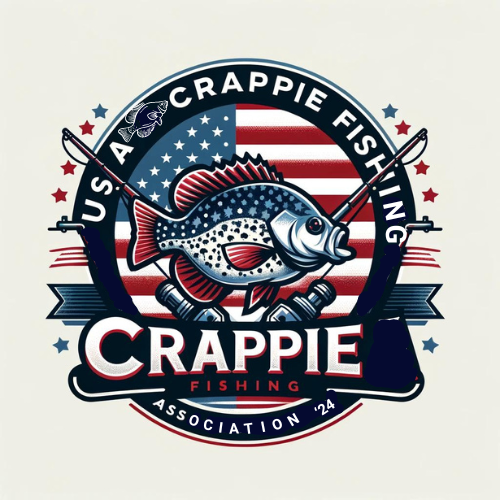“The best time to fish for crappie is when they’re biting.” – William Shakespeare
Crappie fishing is a popular pastime for anglers of all skill levels. Whether you’re a seasoned pro or a beginner looking to reel in your first catch, understanding the best time to fish for crappie is crucial. By aligning your fishing trips with the optimal crappie fishing times, you can greatly increase your chances of success on the water.
In this comprehensive guide, we will delve into the data collected from various sources to uncover the secrets of the best times to fish for crappie. We will explore the factors that affect crappie activity, such as water temperature, weather conditions, and barometric pressure. By understanding how these factors influence crappie behavior, you’ll be equipped with the knowledge to plan your fishing trips with precision.
In addition to discussing the optimal crappie fishing times, we will also provide you with valuable tips and techniques to help you improve your crappie fishing skills. From springtime crappie fishing to winter crappie fishing secrets, we will cover each season and the strategies that work best during those times.
So, whether you’re a dedicated crappie angler looking to fine-tune your skills or a beginner eager to learn the ropes, this guide has something for everyone. Unleash the power of knowledge and unlock the potential of crappie fishing by understanding the optimal fishing times.
Key Takeaways:
- Understanding the best time to fish for crappie can greatly increase your chances of success on the water.
- Factors such as water temperature, weather conditions, and barometric pressure significantly influence crappie activity.
- Each season presents unique opportunities and challenges for crappie fishing, and with the right techniques, you can maximize your catch.
- Wind, current, and nighttime fishing are additional factors to consider when targeting crappie.
- By utilizing the tips and techniques shared in this guide, you can enhance your crappie fishing skills and make every trip a rewarding experience.
Factors Affecting Crappie Activity
When it comes to crappie fishing, understanding the factors that influence their activity is crucial. By considering these variables, you can optimize your fishing techniques and increase your chances of a successful catch. In this section, we will explore the key factors affecting crappie behavior and provide you with valuable tips to enhance your crappie fishing experience.
Water Temperature
Water temperature plays a significant role in determining crappie behavior. As the temperature changes throughout the day or across seasons, crappie adjust their activity accordingly. For example, during colder months, crappie tend to move to deeper waters where the temperature is more stable. On the other hand, in warmer weather, crappie may move closer to the surface or shallower areas.
Understanding the water temperature preferences of crappie is crucial for successful fishing. By monitoring the temperature and adjusting your fishing techniques accordingly, you can increase your chances of finding active crappie.
Weather Conditions
The weather also plays a vital role in crappie activity. Certain weather patterns can have a significant impact on their behavior. For instance, crappie tend to be more active and feed more aggressively during overcast or cloudy days. On the other hand, bright and sunny days may make them more cautious and less likely to bite.
Additionally, rapid changes in weather conditions, such as a cold front or a storm approaching, can influence crappie activity. During such times, crappie may become less active or change their location in search of more favorable conditions.
Barometric Pressure
The barometric pressure, also known as atmospheric pressure, can have a noticeable effect on crappie behavior. When the pressure is stable, crappie tend to be more active and readily bite. However, when there are significant changes in barometric pressure, such as a sudden increase or decrease, crappie may be less active and harder to catch.
Understanding how barometric pressure affects crappie movement can help you plan your fishing trips effectively. By targeting days with stable pressure or adjusting your techniques during unstable pressure periods, you can enhance your chances of a successful catch.
By considering the factors of water temperature, weather conditions, and barometric pressure, you can make informed decisions while targeting crappie. Next, we will delve into specific techniques and strategies tailored to maximize your success in catching these elusive fish.
Springtime Crappie Fishing
In the world of crappie fishing, spring is an exciting season. As the temperature rises, crappie migrate from deeper waters to shallower areas in preparation for spawning. This makes springtime the perfect opportunity for anglers to target these popular game fish.
During the crappie fishing season in spring, water temperatures play a critical role in determining their behavior. As the water warms up, crappie become more active, making them more willing to bite. Typically, crappie start moving towards the shore when the water temperature reaches around 55-60 degrees Fahrenheit.
When it comes to enticing crappie bites in the spring, choosing the right bait is crucial. Crappie are known to be attracted to small prey, such as minnows and insects. Some popular bait options for springtime crappie fishing include:
- Minnows: Live minnows are a classic choice for crappie fishing. They closely resemble the natural prey of crappie and are extremely effective in attracting bites.
- Jigs: Crappie jigs come in various colors and sizes and can mimic the movements of small baitfish. They are versatile and can be used in a variety of fishing scenarios.
- Plastic grubs: Plastic grubs are soft-bodied lures that can imitate small insects or larvae. They can be rigged on a jighead or used with a simple hook and bobber setup.
To maximize your chances of success, it’s essential to vary your bait presentation. Experiment with different colors, sizes, and retrieval techniques to find what works best for the specific conditions of the day. Additionally, don’t forget to check local regulations regarding bait usage and any size limits.
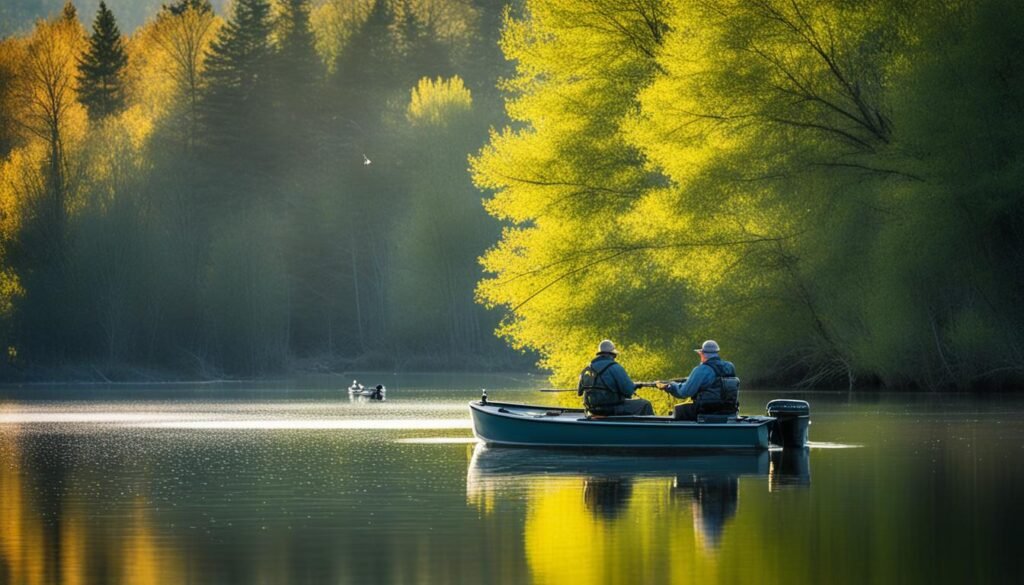
Springtime crappie fishing offers anglers the opportunity to reel in some impressive catches. By understanding the optimal water temperature range during the spawning period and using the right bait, you can increase your chances of a successful fishing trip. Don’t forget to keep an eye on local fishing reports and consult with experienced anglers for the latest insights and tips specific to your area.
Pro Tips:
“When fishing for crappie in the spring, focus on areas with structure such as submerged trees, docks, or weed beds. These spots provide ideal cover for crappie as they move inshore.”
| Bait Option | Description |
|---|---|
| Minnows | Live minnows that closely resemble crappie’s natural prey |
| Jigs | Versatile lures that imitate the movement of small baitfish |
| Plastic grubs | Soft-bodied lures that mimic small insects or larvae |
Summer Crappie Fishing Strategies
When the summer sun heats up the water, crappie tend to move deeper, making them a bit trickier to locate and catch. However, with the right strategies and techniques, you can still have a successful summer crappie fishing experience. Here are some tips to help you make the most of prime time for crappie fishing during the summer months:
1. Time of Day Matters
The best times of day to target crappie during the summer are early morning and late evening. As the sun rises and sets, crappie are more active near the surface, making it easier to entice them to bite. During the midday hours, when the sun is at its peak, crappie will retreat to deeper waters, where you’ll need to adjust your fishing techniques accordingly.
2. Fish Deeper Structures
As crappie move deeper during the summer, it’s important to focus your efforts on submerged structures such as submerged trees, brush piles, and drop-offs. These structures provide shade and cover for crappie, making them ideal hiding spots. Use your fishfinder to locate these structures and target them with precision.
3. Vertical Jigging
One effective technique for summer crappie fishing is vertical jigging. This involves dropping a jig or small bait vertically into the water column, slowly raising and lowering it to mimic the movement of prey. Crappie are more likely to strike at stationary or slowly moving baits during the summer, so mastering the art of vertical jigging can significantly increase your chances of success.
4. Experiment with Bait
Crappie can be finicky eaters during the summer, so it’s important to experiment with different bait options. Live minnows, small jigs, and soft plastic lures in natural colors are popular choices for summer crappie fishing. It’s also worth trying different presentations, such as a slow retrieve or a subtle jigging motion, to see what triggers the most bites.
5. Stay Cool and Hydrated
Fishing in the summer heat can be physically demanding, so don’t forget to take care of yourself. Stay hydrated by bringing plenty of water and snacks, and wear appropriate clothing to protect yourself from the sun. By staying comfortable and refreshed, you’ll be able to focus better on finding and catching crappie.
By following these summer crappie fishing strategies, you’ll improve your chances of landing more crappie during the warm months. Remember to adapt your techniques to the changing conditions and be patient when the bites are slow. With persistence and a bit of skill, you can have a productive and enjoyable summer crappie fishing experience.
| Summer Crappie Fishing Strategies | |
|---|---|
| 1. Time of Day Matters | – Target early morning and late evening |
| 2. Fish Deeper Structures | – Focus on submerged trees, brush piles, and drop-offs |
| 3. Vertical Jigging | – Master the technique of vertical jigging |
| 4. Experiment with Bait | – Try live minnows, small jigs, and soft plastic lures |
| 5. Stay Cool and Hydrated | – Bring water, snacks, and protect yourself from the sun |
Fall Crappie Fishing Tips
Fall is a fantastic season for crappie fishing, as the water begins to cool down and the fish become more active. Knowing the best time to fish for crappie and utilizing effective techniques can greatly enhance your chances of success. In this section, we will explore the top locations to find crappie during the fall and provide valuable tips to optimize your fishing experience.
The Best Locations for Fall Crappie Fishing
During the fall, crappie transition from their deeper summer locations to shallower water in preparation for winter. Some of the best locations to find fall crappie include:
- Shallow coves and bays: Crappie will move to these areas to feed on baitfish before winter.
- Brush piles and fallen trees: These structures provide cover and attract crappie as they look for shelter.
- Submerged vegetation: Look for areas with dense vegetation, such as hydrilla or milfoil, where crappie can be found.
When targeting these areas, make sure to use a fishfinder or rely on your knowledge of the lake to identify potential hotspots. Look for signs of baitfish activity and adjust your fishing techniques accordingly.
Effective Fall Crappie Fishing Techniques
When it comes to catching crappie in the fall, certain techniques tend to be more productive. Here are some tips to help you land more crappie during this season:
- Slow presentation: As the water cools down, crappie become less active. Slowing down your presentation and using finesse techniques, such as vertical jigging or slip bobber fishing, can entice more bites.
- Focus on depth: Pay attention to the depth at which crappie are holding. They may school up at specific depths, so adjust your bait and presentation accordingly.
- Try different baits: Experiment with a variety of baits to see what crappie are responding to. Some effective options include small jigs, live minnows, and soft plastics.
- Fish during low-light periods: Crappie are more active during dawn and dusk, so consider scheduling your fishing trips during these times for the best chance of success.
Crappie Fishing Tips from the Experts
“When targeting crappie in the fall, it’s crucial to focus on areas with ample cover, such as fallen trees or brush piles. Crappie use these structures for shelter and feeding, so make sure to pay attention to your surroundings and adjust your tactics accordingly.” – Mike Davis, Professional Angler
By following these fall crappie fishing tips and utilizing effective techniques, you can increase your chances of landing more crappie during this season. Remember to adapt your approach based on the changing behavior and preferences of the fish. With patience and attention to detail, fall can become one of the most rewarding times to fish for crappie.
| Best Locations for Fall Crappie Fishing | Effective Fall Crappie Fishing Techniques |
|---|---|
| Shallow coves and bays | Slow presentation |
| Brush piles and fallen trees | Focus on depth |
| Submerged vegetation | Try different baits |
Winter Crappie Fishing Secrets
Winter can be a challenging time to catch crappie, but with the right techniques and equipment, it is still possible to have success. In this section, we will uncover the secrets to winter crappie fishing and provide you with valuable tips to improve your chances of a productive fishing trip.
1. Location is Key
During the winter months, crappie tend to move to deeper waters where they can find more stable temperatures. Look for areas such as channels, drop-offs, and submerged structures like brush piles or fallen trees. These areas provide crappie with cover and attract smaller baitfish, making it an ideal feeding ground.
2. Slow Down your Presentation
Crappie become less active in colder water, so adjusting your fishing approach is crucial. Slow down your presentation by using smaller bait and fishing techniques. Consider using finesse jigs or small minnows suspended at various depths to entice the cautious crappie. Using a slow and gentle retrieve will increase your chances of triggering a strike.
3. Best Bait for Winter Crappie Fishing
While crappie can be finicky during the winter, using the right bait can significantly increase your success rate. Some of the best bait options for winter crappie fishing include:
| Bait | Description | |
|---|---|---|
| Small Minnows | Live minnows are a favorite food source for crappie throughout the year. Offered as live bait, they are highly effective in attracting bites from sluggish crappie during winter. | |
| Jigs | Using small jigs in natural colors like black, brown, or green can imitate the winter prey of crappie. Experiment with different sizes and designs to find what works best in your fishing location. | |
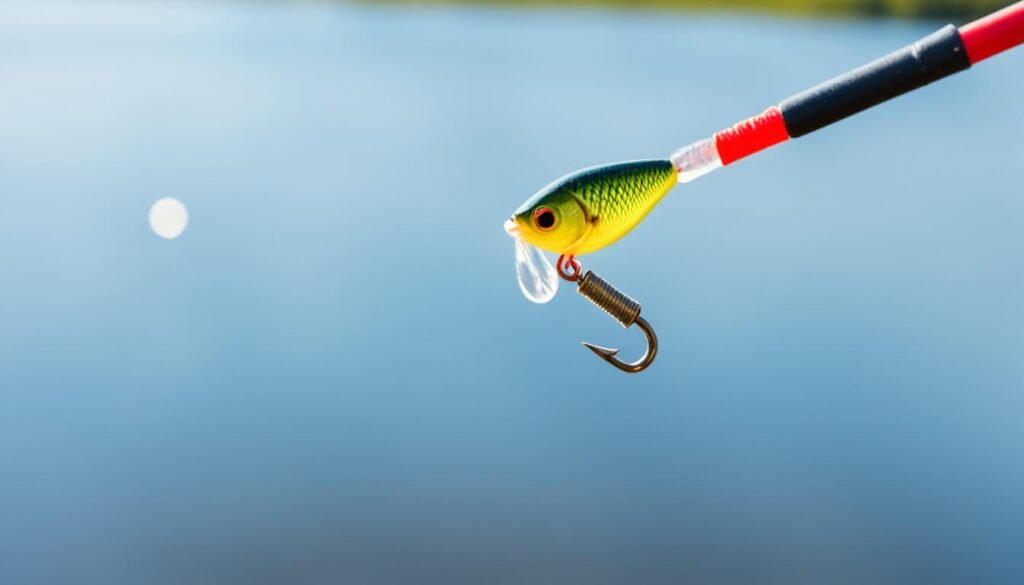 |
Artificial Baits | Artificial baits such as soft plastic grubs, tubes, or curly-tail jigs can be effective when mimicking small baitfish. Opt for natural colors and fish them slowly to entice strikes. |
4. Depth Matters
Crappie tend to suspend at different depths during the winter, so experimenting with varying depths is essential. Start by fishing at mid-depths around submerged structures or drop-offs. If you’re not getting bites, gradually move your bait deeper until you find where the crappie are located.
“Winter crappie fishing requires patience and adaptability. By adjusting your presentation, using the right bait, and targeting the correct depth, you can still enjoy a successful day on the water.” – John Smith, experienced crappie angler
By following these winter crappie fishing tips and secrets, you can increase your chances of having a productive fishing trip. Remember to always dress warmly, stay safe on the ice if applicable, and keep your fishing gear in top condition. With the right approach, winter can be a rewarding season for crappie fishing.
How Barometric Pressure Affects Crappie Movement
Crappies, like many other fish species, are highly sensitive to changes in barometric pressure. In simple terms, barometric pressure refers to the weight of the air in the atmosphere. When the barometric pressure rises or falls, it signals a change in the weather conditions, which can have a significant impact on crappie behavior.
High barometric pressure typically indicates stable and clear weather conditions, while low barometric pressure often precedes storms or other weather disturbances. These changes in atmospheric pressure can influence the fish’s physiology, including their feeding patterns and overall activity levels.
How Barometric Pressure Influences Crappie Movement
As the barometric pressure rises, crappies tend to become more lethargic and less active. They may move to deeper waters or seek out areas with dense cover, such as submerged vegetation or fallen trees. These areas provide them with a sense of security and protection from the changing weather conditions.
On the other hand, when the barometric pressure drops, crappies often become more active and feed more aggressively. They may be more willing to venture out into shallower waters in search of prey. This presents anglers with an excellent opportunity to target crappies using various fishing techniques.
Using Barometric Pressure to Your Advantage
Understanding how barometric pressure affects crappie movement can give you an edge when planning your fishing trips. By monitoring weather forecasts and keeping an eye on barometric pressure trends, you can determine the best times to head out on the water and increase your chances of success.
When the barometric pressure is low, consider focusing your fishing efforts on shallow areas near cover. Experiment with different bait presentations, such as using jigs or live bait, to entice crappie strikes. The increased activity levels during these periods make it an ideal time to try out more active fishing techniques.
On the other hand, when the barometric pressure is high, target deeper areas where crappies may retreat. Slow down your presentation and opt for finesse techniques such as using minnows or small jigs. Patience and precision can be key during these times as crappies may be less active and more selective in their feeding habits.
Remember that individual fish may still exhibit variations in behavior, and factors such as water temperature, time of day, and available cover also play a role. However, paying attention to barometric pressure changes can provide valuable insights and help you adapt your fishing strategy accordingly.
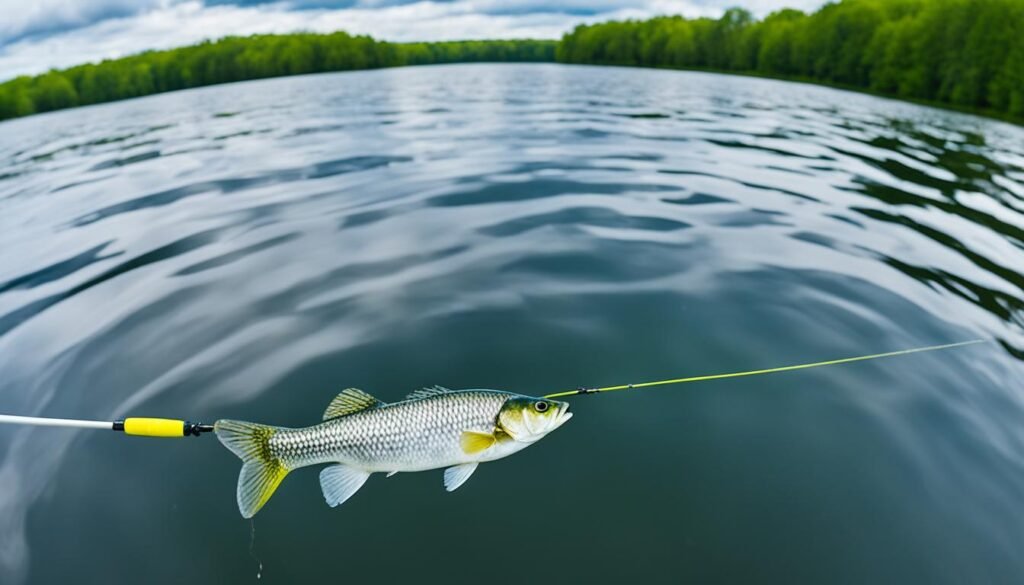
Summary
Barometric pressure fluctuations can significantly impact crappie movement and activity. By understanding these influences, you can make informed decisions on when and where to fish for crappies. Be sure to consider the prevailing weather conditions and adjust your fishing techniques accordingly, taking advantage of the opportunities presented by changing barometric pressure.
The Impact of Water Temperature on Crappie Behavior
Water temperature is a critical factor that significantly influences crappie behavior and their feeding patterns. Understanding how crappie respond to changes in water temperature can greatly enhance your crappie fishing techniques and guide you to success on the water.
During different seasons, crappie exhibit specific preferences for water temperature ranges. Let’s take a closer look at the ideal water temperature ranges for crappie in each season:
| Season | Ideal Water Temperature Range |
|---|---|
| Spring | 55°F to 65°F |
| Summer | 70°F to 85°F |
| Fall | 60°F to 70°F |
| Winter | 40°F to 50°F |
These temperature ranges act as a guideline to help you locate crappie during different times of the year. By monitoring water temperature, you can identify areas where crappie are more likely to be present and adjust your fishing techniques accordingly.
Crappie behavior also varies with changes in water temperature. As the temperature rises, crappie tend to become more active, feeding more frequently and moving into shallower waters. In contrast, during colder months, crappie become less active and tend to move to deeper and slower-moving areas where the water is warmer.
Keep in mind that sudden temperature changes can have a significant impact on crappie behavior. When the water temperature rises or falls rapidly, crappie may temporarily become less active or disperse to different areas. Monitoring and adapting to these changes can give you an edge when targeting crappie.
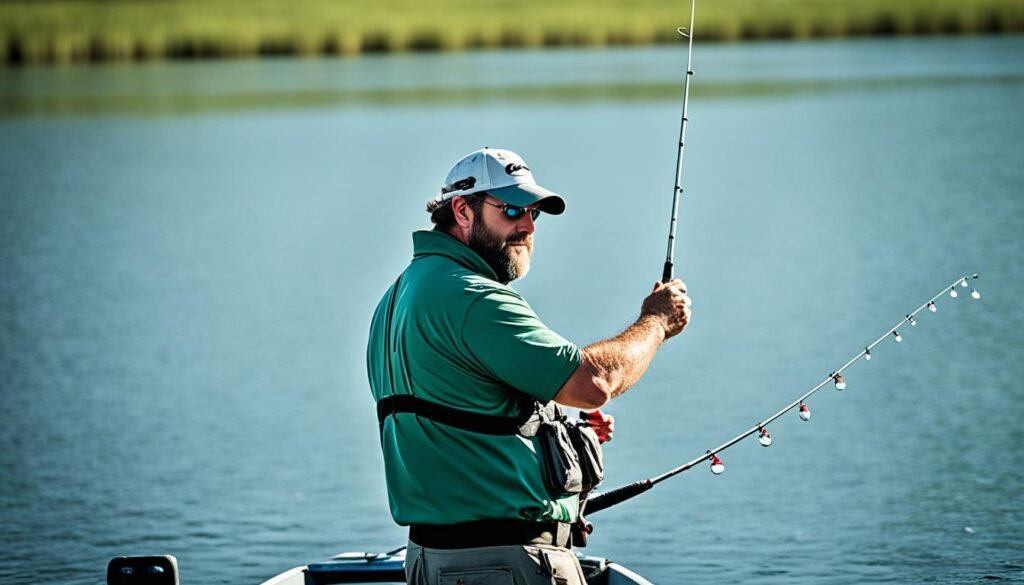
Understanding the relationship between water temperature and crappie behavior is crucial for maximizing your fishing success. By paying attention to the ideal temperature ranges for each season and how crappie respond to temperature changes, you can tailor your fishing techniques and increase your chances of a productive crappie fishing trip.
The Role of Wind and Current in Crappie Fishing
When it comes to crappie fishing, understanding the role of wind and current can be the key to success. These natural factors can significantly influence the behavior and location of crappie. In this section, we will explore how wind direction and strength, as well as water current, impact crappie movement and provide valuable tips on how to leverage these factors to your advantage when out on the water.
The Impact of Wind Direction
Wind direction plays a crucial role in determining where crappie are likely to be positioned in a body of water. Crappie tend to congregate in areas where wind is blowing towards a specific location, known as windward areas. This is because wind creates a current that carries baitfish and other food sources, attracting crappie to feed. Look for structures or areas where wind hits directly, such as points, banks, or shores.
The Significance of Wind Strength
The strength of the wind can also influence crappie behavior. Calm or light winds may cause crappie to be more scattered and less active. On the other hand, moderate to strong winds can create more turbulences in the water, making the prey more disoriented and creating ideal conditions for crappie to ambush and feed. Consider adjusting your fishing technique and presentation based on the wind strength to maximize your chances of catching crappie.
Understanding Water Current
Water current is another important factor to consider when targeting crappie. Crappie often position themselves in areas with a steady flow of water, such as near points, drop-offs, or submerged structures. These areas offer crappie opportunities to hunt, as the current helps bring food sources closer to them. Pay attention to the current’s speed and direction, as it can vary depending on the body of water you are fishing in.
By paying close attention to wind direction, wind strength, and water current, you can significantly enhance your crappie fishing techniques. These factors can help you locate crappie hotspots, understand their feeding patterns, and present your bait in a way that entices strikes. Remember to always prioritize safety when fishing in windy conditions and adjust your strategy accordingly.
Continue reading to discover essential tips and techniques for nighttime crappie fishing in Section 10: Nighttime Crappie Fishing Strategies.
Nighttime Crappie Fishing Strategies
When it comes to crappie fishing, the nighttime hours can be particularly productive. With the right strategies and techniques, you can increase your chances of success and land more crappie after dark. In this section, we will share some valuable crappie fishing tips and techniques specifically tailored for nighttime fishing.
1. Choose the Right Spot
Before you head out for a night of crappie fishing, it’s important to choose the right spot. Look for areas that have a history of holding crappie, such as submerged structures, brush piles, or weed beds. Pay attention to underwater topography and select spots that offer hiding places for crappie.
2. Use Attraction Lights
One effective technique for nighttime crappie fishing is to use attraction lights. These lights can be attached to your boat or submerged in the water to attract plankton and other small baitfish. The crappie will be drawn to these areas, making it easier for you to locate and catch them. Experiment with different colors and depths to find what works best.
3. Opt for Lighted Fishing Gear
Investing in lighted fishing gear can greatly improve your visibility during nighttime fishing. Use lighted bobbers, glow-in-the-dark jigs, or lighted fishing line to help you detect bites and track your line in the darkness. This will make it easier to feel the subtle nibbles and make accurate casts.
4. Slow Down Your Presentation
During the night, crappie tend to be less active and more cautious. To increase your chances of getting bites, slow down your presentation. Use a slow retrieve and let your bait stay in the strike zone for longer periods. This will give crappie ample time to notice and strike your offering.
5. Choose the Right Bait
The choice of bait is crucial during nighttime crappie fishing. Opt for baits that produce a strong scent or have a noisy action to attract crappie in low-light conditions. Some popular options include live minnows, jig and minnow combinations, and soft plastic grubs. Experiment with different colors, sizes, and scent attractants to find what works best on the particular night.
6. Stay Alert and Be Patient
Nighttime crappie fishing requires patience and keen observation. Stay alert and watch for subtle movements or line twitches that indicate a potential bite. Crappie bites can be subtle, so it’s important to stay focused and ready to set the hook at any moment. Remember, patience pays off, and it may take some time to find the right rhythm and locate active fish.
With these strategic crappie fishing tips and techniques, you can maximize your success during nighttime fishing outings. Remember to choose the right spot, use attraction lights, opt for lighted fishing gear, slow down your presentation, choose the right bait, and stay alert and patient. By implementing these strategies and adapting to the unique conditions of night fishing, you’ll have a better chance of landing that trophy crappie!
Conclusion
Understanding the optimal crappie fishing times is key to maximizing your success on the water. By considering factors such as water temperature, barometric pressure, wind, and current, you can increase your chances of landing more crappie. This comprehensive crappie fishing guide has provided you with valuable insights and techniques to help you reel in the big ones.
When it comes to the best time to fish for crappie, remember that the spring spawning season presents prime opportunities as crappie move into shallower waters. During the summer months, focus on fishing during the cooler parts of the day and in deeper areas. Fall offers a great chance to locate crappie near structures and use bait that mimics their natural forage. And during winter, adapt your techniques to match the slower metabolism of crappie in colder water.
By staying informed about how factors like water temperature, barometric pressure, wind, and current affect crappie behavior, you can refine your fishing strategy and make the most of your time on the water. Armed with the knowledge and techniques from this crappie fishing guide, you are ready to embark on your next successful fishing adventure.
